This post contains affiliate links to products, services, or education. We may receive a commission for purchases made through links.
When welding with different kinds of steel, it can be tricky to get the metals to work well together and also avoid rusting in your final product. Welding dissimilar metals can be tricky in many situations, however, some can be welded successfully. So, how do you weld stainless steel to carbon steel?
Stainless steels including a grade 304 or grade 316 can be welded to a plain carbon steel using metal arc welding (MIG) or tungsten arc welding (TIG) welding. However, MIG welding is recommended due to the different melting temperatures of the different steels because it uses a filler material to connect the different steels.
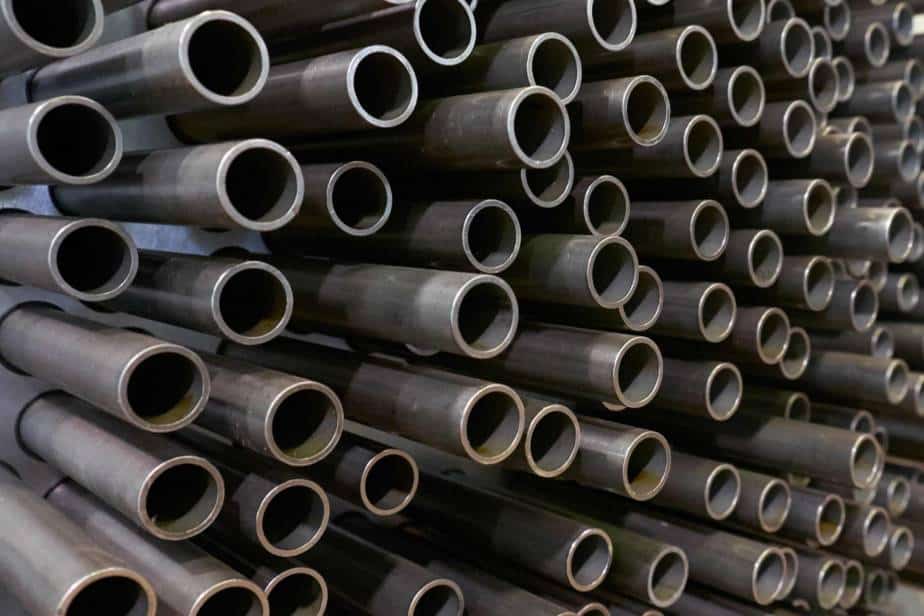
Although many welders choose not to weld dissimilar metals together due to the challenge this can present, it can be done! In this article, we will walk you through how to properly weld stainless steel to carbon steel, what to avoid in this process, and present you with the challenges you may face throughout your project.
Potential Difficulties Welding Stainless Steel to Carbon Steel
Since this is a more difficult process, those who are not as skilled or experienced in welding may have difficulties melding two different metals together. This process can often result in increased labor, error rates, and cost on the project.
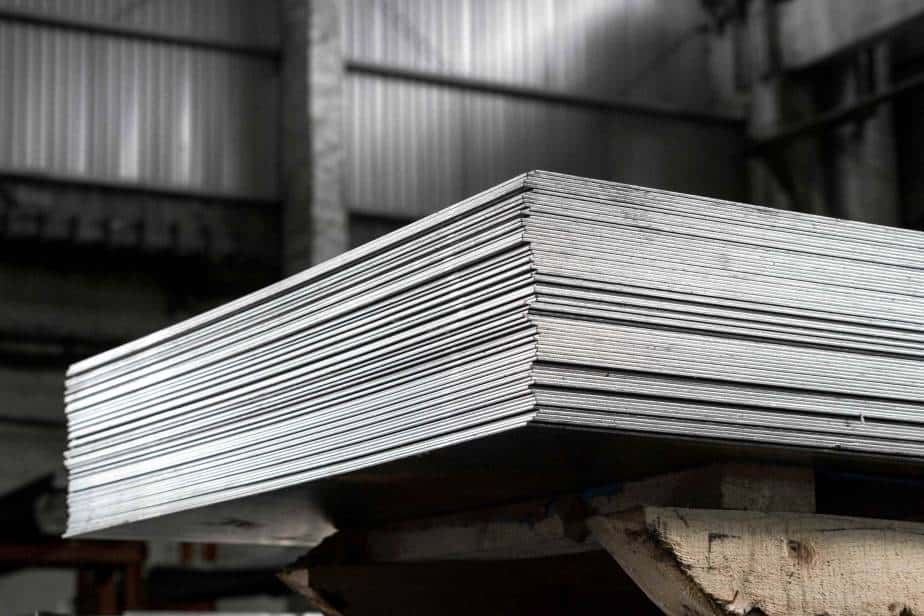
With this type of project, it is more likely that you will experience hot cracking of the stainless steel being used. Since this metal is more electrically resistant than carbon steel, the stainless steel will heat up much faster if resistance welding is used. This can cause overheating which generally results in the metal cracking.
It is also important to keep in mind that the thermal expansion from the heat will impact each of your metals in different ways. Since each metal will expand differently, there can be increased fatigue to the welded joint which in the long run can reduce the wire form’s structural integrity. This can add significantly more time and cost if your joints won’t hold.
Unlike carbon steel, stainless steel has strong corrosion resistance. For steel that is being exposed to conditions that can cause corrosion, such as being immersed in salt water, can compromise the integrity of the steel. Unfortunately, when stainless steel gets mixed with particles from carbon steel, it destroys the protective oxide layer that prevents rust.

Therefore, when mixing these two metals, you are putting your stainless steel at high risk for rust which can majorly impact the soundness of your project. This contributes to a weaker final product. In addition, when mixing metals, the weld is often not as strong even when using filler based welding methods.
This compromised strength is generally due to the differences in melting points and welding temperatures in addition to the operational tolerance of each metal. Projects that mix metal types simply will not result in as strong of a weld as those that use a consistent metal throughout the project.
These are some of the major concerns to consider when taking on a job that mixes carbon metal with stainless steel. Now that you are aware of some of the downfalls and risks, let’s talk about how you can complete this project and the exact methodology for welding these two metals together.
Resistance Welding with Dissimilar Metals
When welding stainless steel to carbon steel, the use of resistance welding is not typically done. It is important to keep in mind that there is a difference in electrical conductivity between stainless and carbon steel. This makes reaching the right temperature for welding more challenging.
If you are set on trying to use resistance welding for two different metals, it is recommended to preheat the metals. Remember, carbon steel is the more electrically conductive one. This means that it does not heat up as quickly as stainless steel. Be sure to give it more time. If you choose not to preheat the metals, you will not have even heating between the two which will pose challenges.
Why Welding Stainless Steel is Difficult
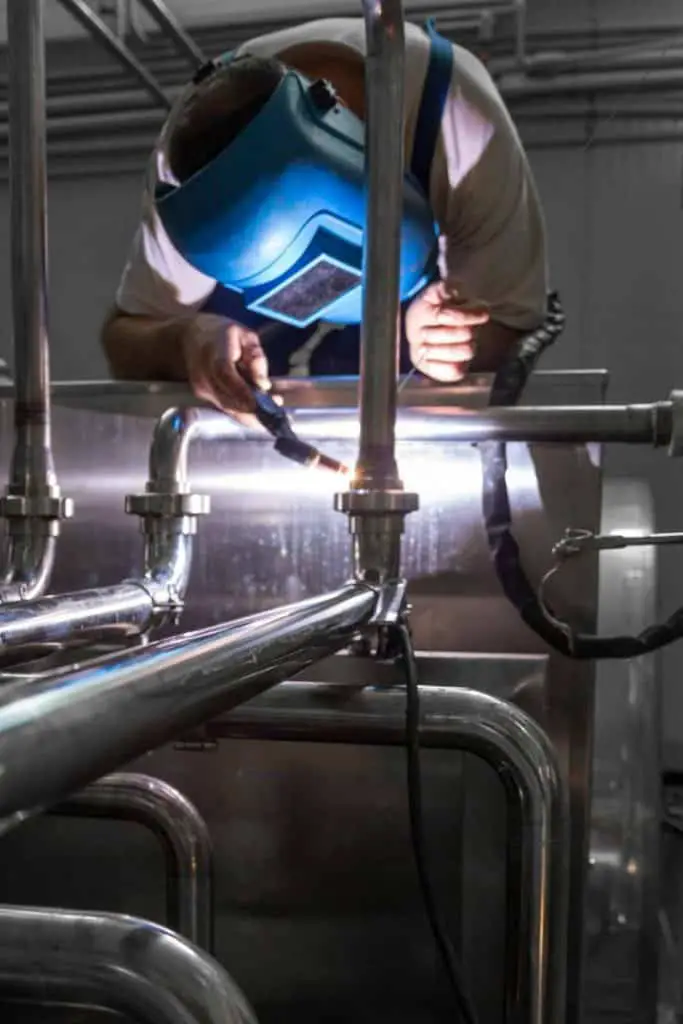
Welding stainless steel can be difficult because it retains heat very efficiently. Due to this heat efficiency, the steel can warp very easily in high temperatures and distort while it is left to cool. This makes it very difficult to work with as you may find your results vary after you are finished with the welding and you have left the steel to cool. This article on American Torch Tip gives a great overview. So does this video via weld.com.
In addition, stainless steel is a very unforgiving metal. Any blemish or scratch that is left behind will show and as a result, you may not end up with the aesthetic you were hoping for. Especially for those who are newer to welding, stainless steel can give users trouble as it will show scratches very easily.
If you are a more experienced welder and tend to make fewer mistakes, using stainless steel may be a great choice. Keep in mind that welded stainless steel can also rust under extreme circumstances. Stainless steel does have a chromium oxide layer that prevents rusting, however, if this layer is destroyed or removed during welding, heating, or cooling, the metal will rust.
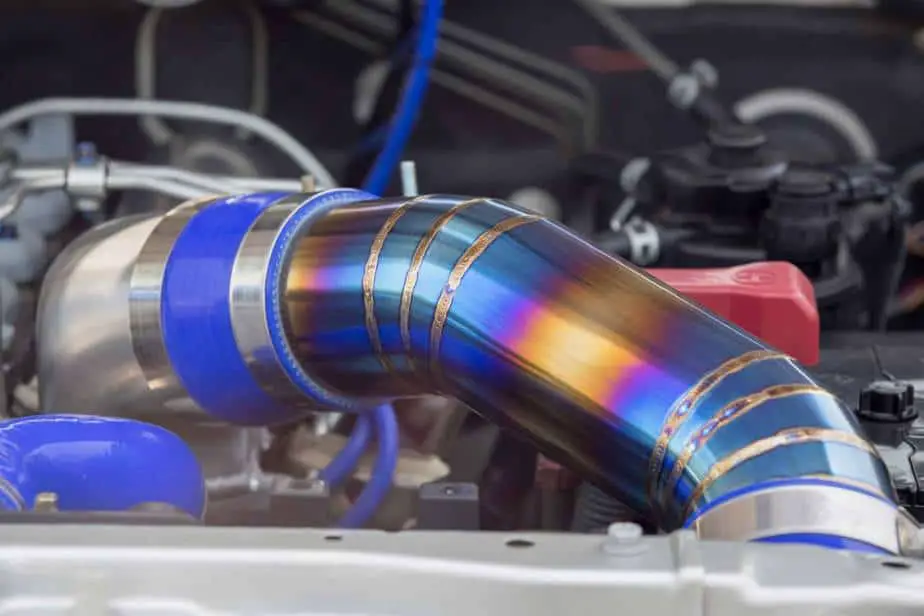
In order to make your welding process smoother, it is recommended to keep a separate set of tools for prepping and cleaning your stainless steel before you start welding. If your tools have any carbon steel residue that comes in contact with the stainless steel, they will become embedded into your final product and will cause rust. I’m assuming you chose the stainless steel to avoid rusting, so just something to keep in mind.
When welding stainless steel, you can use shielded metal arc welding (MIG), gas tungsten arc welding (TIG), and stick welding. All of these will offer different results and the process used should be determined by the following factors:
- The skill level of the welder
- The aesthetics of the final piece (especially if you are using bead appearance)
- The thickness of the metal being used
- The costs and timing of the project
For those who value artistry or aesthetics, TIG welding is often the best fit (especially if you back purge your TIG weld); however, if speed and efficiency are a higher priority, then MIG welding is likely going to be the better process for the project.
What Welding Rod Do I Use to Weld Stainless to Carbon Steel?
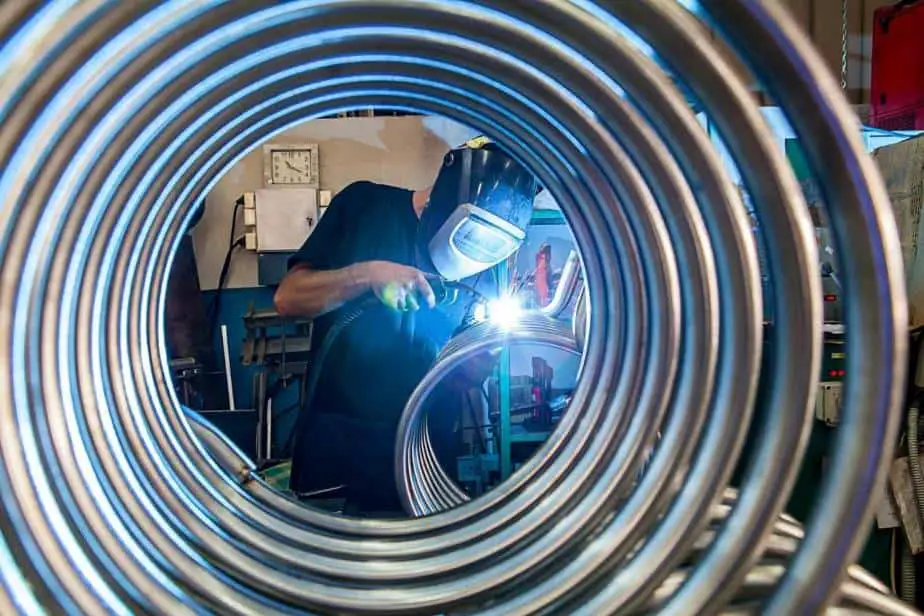
It is recommended to use a 309L when you are joining stainless steel with a more milk steel, which includes carbon steel. You can also use CG-12 which is the cast equivalent to using a 309. The benefit of using 309L is that it contains no molybdenum.
Be sure to check out our article “5 things to know to choose the right welding rod” here for a more in-depth look.
How to MIG Weld Stainless Steel to Carbon Steel?
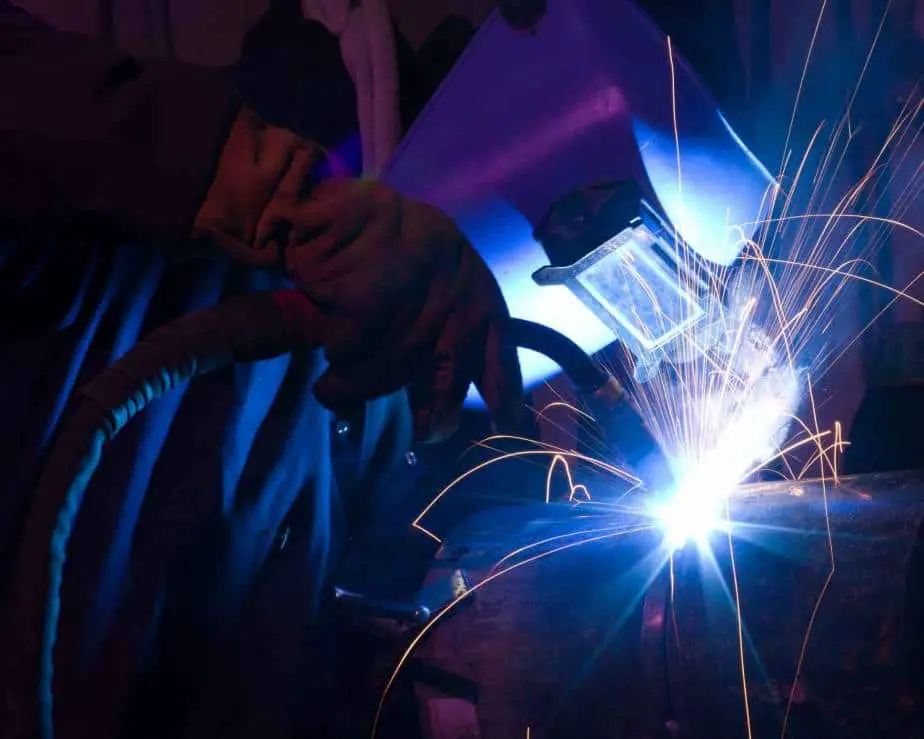
If you are wanting a solid introduction to MIG welding, please check out our article here to begin your journey. MIG welding is a great option for welding two different metals, some of the advantages to using this form of welding include:
- The ability to join a range of metal and thicknesses together
- Welding capability in all positions
- A good weld bead
- A minimum of weld splatter
- Very easy to learn
However, when using this method, it is also important to remember that there are disadvantages that may influence if you want to use this process or not.
- This type of welding can only be used when you are welding thin to medium thick metals
- This is a less portable style of welding than arc welding because it requires inert gas
- This will produce a sloppier result because you will have less control than you have with TIG
MIG welding is recommended when welding two different metals together. This is because MIG welding uses a continuously fed electrode wire that melds into the weld. This allows the two dissimilar metals to join together without having to heat them to their melting points.
This is critical since stainless and carbon steel have differing melting points often making them difficult to weld together. When using MIG, you will have your welder which has a spool of wire inside and a series of rollers that will push the wire out of the welding gun. You will also have a gas tank that is either 100% Argon or a mixture of CO2 and Argon.
If you do not have gas, your weld will come out looking brown and splattered which is not ideal. Be sure your gauges read between 0 and 2500 PSI in your gas tank and set your regulator to between 15 and 25 PSI. Open all of the valves in the gas tanks about a half turn to avoid overloading your valve with pressure. This will also ensure you can quickly cut the gas in case of an emergency.
You should also have a welding gun that controls the wire feed and flow of electricity. Last, you will need a ground clamp to complete the circuit between the welder, welding gun, and project. You should clip this directly onto the metal being welded or onto a metal welding table.
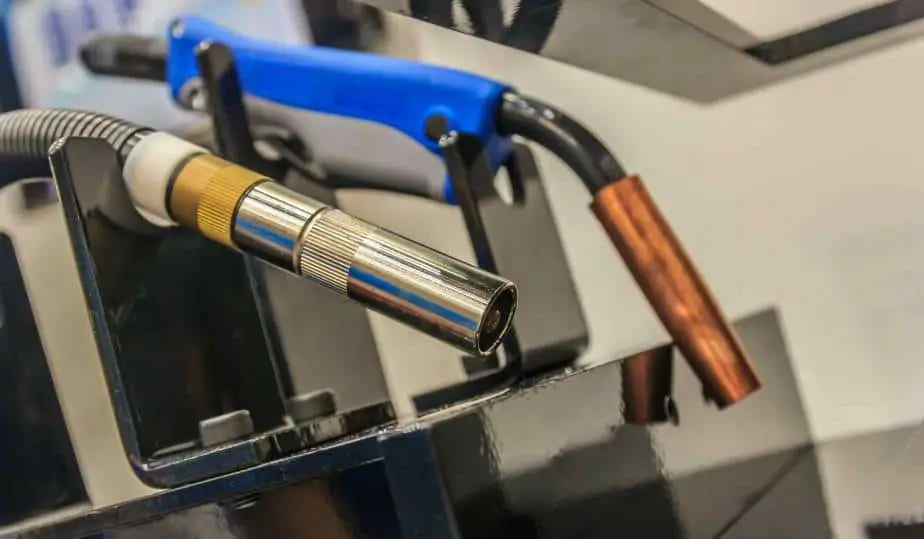
Once all of your tools are set up and you have your safety gear on (check out our recommended welding gear here), you can begin welding by taking your welder and making a sewing motion across the seam. Weld from the bottom up so that you can push the weld bead forward with the tip of the gun. Once you are finished you will want to grind down the weld so that you are not left with a large bump.
This process is only really necessary if the piece will be showing and you want it to look aesthetically pleasing. If you do not care how the weld looks, it is not necessary to grind it down. This is a pretty straight forward process and can be fairly simple even if you are using differing metals.
Can You TIG Weld Stainless Steel to Carbon Steel?
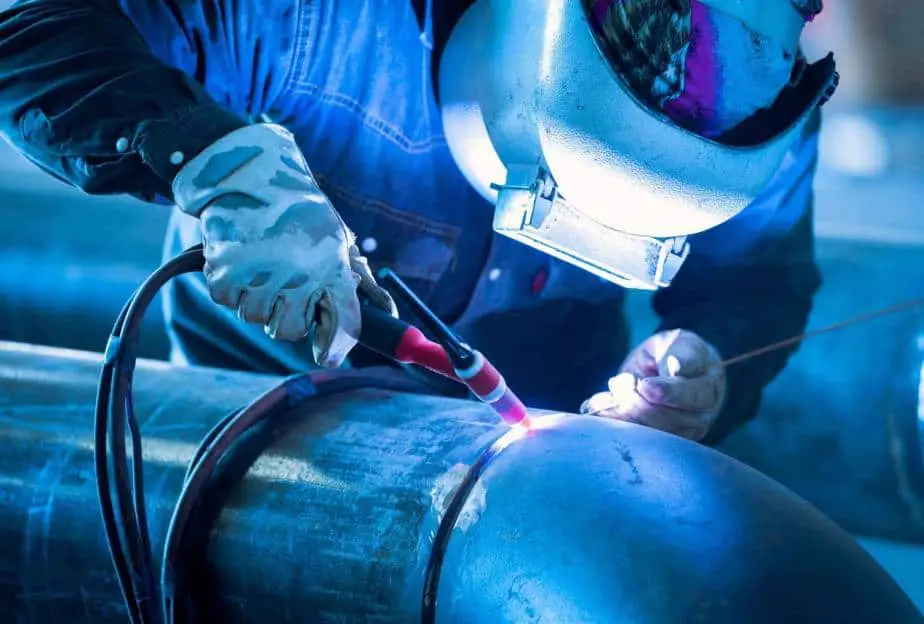
You can absolutely weld plain carbon steel to stainless steel using TIG welding (check out this intro article about what TIG welding is to learn more about why). This is a preferred method over using resistance welding, similarly to the previously described MIG welding. Many welders prefer using TIG welding over MIG welding due to its precision which allows it to often come out looking cleaner and more precise.
This is not a major concern if you are working on a project that will not be seen but for those who are creating an aesthetically pleasing project, TIG welding is definitely the way to go. The TIG welder uses a tungsten electrode as well as a gas nozzle to weld two pieces of metal together. The tools required are an electric torch and filler rod, a gas welding tank (read about what gas is best for TIG welding here), and your standard welding PPE.
Much like MIG welding, you will need a ground cable with a clamp to be attached to the workpiece or metal welding table. The welder has an electric TIG torch on the end and the cable will be a small line that carries the argon gas. Even though you will need a gas bottle and a regulator, do not use the same gas you would use for a MIG welder.
The tungsten rod is the electrode and will not burn up like a filler rod. This electrode can be sharpened to a ball shape depending on what you are welding. The tungsten rod is very handy as it can be adjusted with the copper collet depending on the length you need it to be for your project.
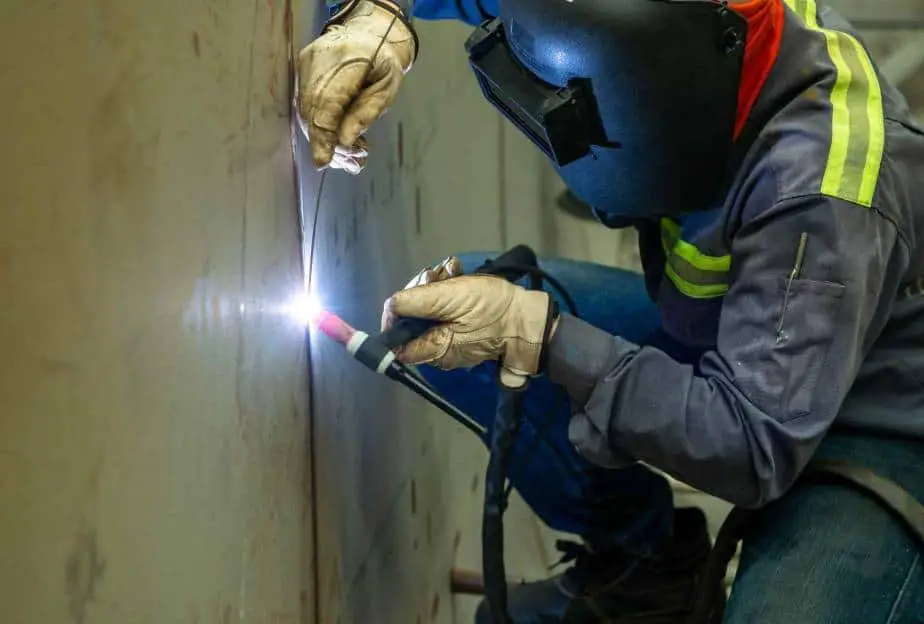
The TIG machines use foot-operated amperage control. When you begin you will want to set your maximum amperage on the machine, you can then vary the amperage up while you are working on your project. The foot control is helpful in slowly initiating heat and slowly reducing heat once you are done welding.
By easing into the temperature, you can better avoid any temperature shock to the metal. This is common in stainless steel and something you need to avoid as mentioned at the start of the article. Be aware of what all of the TIG controls do before you begin welding. The most important function you will want to pay attention to is the balance control.
The balance control maintains the cleaning versus penetration levels. When your balance is higher, you get more penetration. You will typically want to set your balance anywhere from about 70 to 80 percent (or 7-8).
In addition, you can use a normal or pulsed mode on the welder. If you choose to use the pulsed mode, the amperage is going to be automatically varied which can reduce the heat going into the piece of metal. The pulsing will also automatically give your weld a rippled wave pattern.
Once you begin welding, remember that the tungsten piece should never touch the metal piece you are working on. If it does, you will notice that the sound and color will change. If it does, your tungsten will be contaminated, and you will want to slip it out and clean it. This is a very common mistake as you are learning and is no big deal! With more practice, it will happen less.
If you are new to TIG welding, practice with a variety of different heats and feeds on the rod to get a better understanding of your tool and how you can best use it to join stainless steel and carbon steel together for your next project.
What is Galvanic Corrosion?
Galvanic corrosion is the term that encompasses some of the risks previously discussed. Simply put, galvanic corrosion is when one metal causes another to corrode and break down. This can be a huge issue and can occur frequently with connecting stainless steel with carbon steel due to the ability for it to rust and get weaker over time.
However, galvanic corrosion can only start when there is an anode (one metal), a cathode (a second metal), and an electrolyte (often water) present. Therefore, this risk is only present if you are combining metals with an electrolyte present that can cause one metal to give its electrons away to the other metal.
When the giving of electrons starts, that is when the galvanic corrosion commences and the metals will begin to rust. This is a very common problem with carbon and stainless steel as they do not always work well together. While both of these metals are iron-based, stainless steel has chromium that allows it to evade corrosion.
Therefore, when these two sheets of steel are connected and water is present the stainless steel is able to take the electrons of the carbon steel which causes the corrosion process to begin.
App manufacturing has a great blog post about galvanic corrosion found here. I recommend this quick read if you get time.
How Can We Prevent Galvanic Corrosion Between Carbon Steel and Stainless Steel?
One of the main reasons many welders avoid mixing stainless steel and carbon steel is due to galvanic corrosion. Even though these two metals do not get along well, they are both strong and useful metals and therefore many welders like to use them together. Luckily, there are ways to combat galvanic corrosion so that the metals will work well together.
Use a Buffer
The first method is to use a buffer. For example, if you are welding piping you can use pipe shoes or wear pads. Any clamp liner or insulator will reinforce your piping and keep the two metals from rubbing up against each other and causing any corrosion to start. The main win here is that friction is reduced and therefore you will experience less cracking.
If there is less cracking and friction, it makes it inherently harder for the electrolytes to slip into the metals to cause corrosion. Other common buffers include:
- Nylon washers
- Nylon fasteners
- ProTek rods
- Flat plates
All of these can add a protective layer between your two metals and allow you to avoid any galvanic corrosion.
Plate the Carbon Steel
Another effective method in ensuring your steel does not corrode is by galvanizing your carbon steel. This protects your carbon steel without having to change its structure. This is done by coating the surface with a layer of zinc.
Zinc is used because it is lower on the galvanic scale than carbon steel is and therefore it is a more basic substance. The more basic the substance, the less likely it is to give up its electrons. Once you have galvanized your steel, the zinc will sacrifice its electrons whenever a corrosive metal connects with the surface.
This will keep the carbon steel sturdier. However, it is very important to note that you should not use MIG welding with galvanized metals. The zinc coating produces carcinogenic and poisonous gas when it is burned which can cause heavy metal poisoning when you are exposed. This exposure can cause flu-like symptoms but can also cause permanent damage.
Of course, you are going to be wearing your respirator anyway. If you need a respirator, check out our recommended units here.
So, before you plate any of your carbon steel, consider what method of welding you are wanting to use and how practical this solution will be for you. If you are going to need to expose your metal to heat, you should avoid plating as you will feel the effects of the burning zinc right away.
Reduce Exposure to Electrolytes
And perhaps our most obvious way to avoid galvanic corrosion is to simply avoid any exposure of your metals to electrolytes. If there are no electrolytes present, there is no way for corrosion to begin. Good ways to accomplish this are to add aeration or just smooth our surfaces whenever possible to reduce exposure.
Additionally, using a waterproofing method can work for a period of time. Adding water-resistant coatings to your metals can preserve them for longer. You can even use a sealant to stop any water or other electrolytes from sliding between the crevices of your metals.
Adding drainage can also be critical. If you have stagnant water that gets into your metal and just sits in there, your project is sure to break down. The pooling water will kick-start the corrosion process so adding weep holes can slow this down. Drill holes into the bottom of hollow supports to give the water a route to exit out of the metal.
Preventing corrosion is a huge part of being a successful welder. There have been huge catastrophes that have occurred due to galvanic corrosion, such as the Santa Barbara oil spill. Situations like this one can be avoided by being more aware of what metals work well together, and how to adjust when you have metals that don’t work well together. Adapt and overcome!
Corrosion is a major hazard but luckily is avoidable by knowing the right steps and actions to take when you are working on a project that could potentially be at risk of corrosion. For additional corrosion resources, check out this App Manufacturing search page. It has some fantastic information so you can start learning more about corrosion.
Final Thoughts
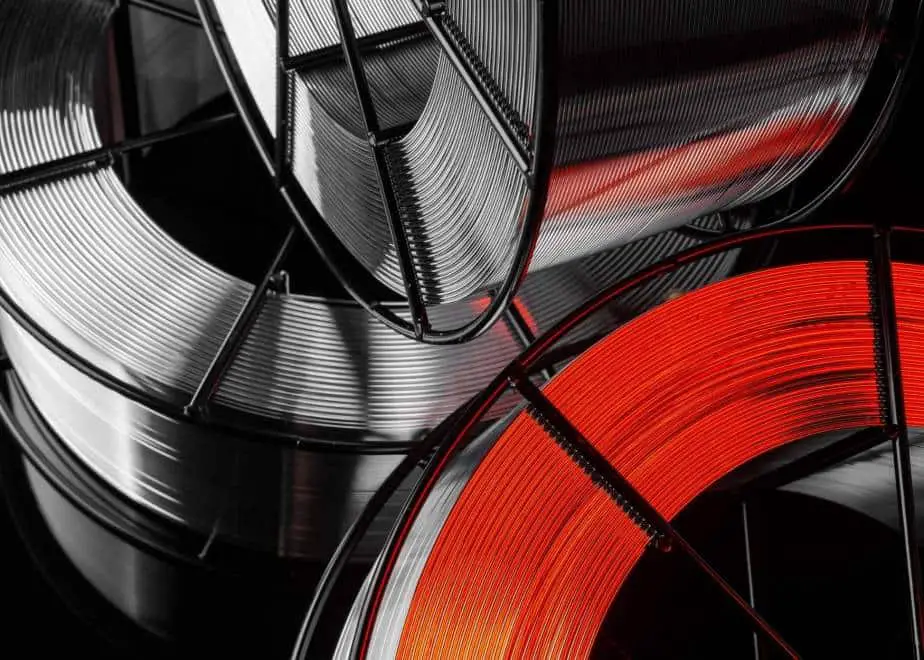
For those who are newer to welding, you may find that completing a piece that requires two different metal types is a bit intimidating and challenging. Remember that when you first get into welding it will take a while to get proficient with the different types of welders and the best technique for your budget, style, materials, and project type.
When welding stainless steel, you are more likely to have differing results as it is more likely to melt and have varying results as it heats and cools. This is normal and will take time to adjust. Once you start welding with stainless steel and carbon steel, be patient and try a variety of welding techniques to find what works best for you and what maintains the best final product.
While resistance welding is a very common form of welding, it should be avoided when it comes to using dissimilar metal types as it will likely only make your project more challenging. Instead, try your hand at MIG or TIG welding. If this is new to you, it may be a good time to experiment on scrap metal first while you get the hang of the different techniques you wish to master.
Once you are more confident in your skills, choose either MIG or TIG welders and begin your project! If you are expecting your final result to be in contact with an electrolyte like water, be sure you are taking precautions to avoid galvanic corrosion from occurring. While stainless steel is unlikely to rust, carbon steel is very susceptible to rust and corrosion.
Once these two are welded together the final product is very susceptible to corrosion when exposed to a third-party electrolyte. Therefore, before beginning your project and choosing your metals, be sure you are aware of what you are going to be doing with this project. If you know you will be submerging it in water, you will probably want to use a different technique.
If you must use these two metals together for the project, take extra precautions to avoid corrosion. While for some smaller projects, corrosion may not be the end of the world, there have been many incidences where galvanic corrosion has caused catastrophes that could have been avoided simply by learning more about welding with corrosive metals.
Take the steps needed to avoid any breakdown of your metals and remember that if you decide to galvanize your metal, you cannot use a MIG welder as this can cause serious health issues for welders. Exposure to toxic gases like these has both short term and long term negative consequences! Additionally, combining these two metals together your project is more likely to be a bit weaker than one that uses a consistent metal type.
While it is possible to use these metals together to complete a project, it can pose additional disadvantages and challenges that you may not have had to deal with in prior projects. But sometimes, you gotta do what you gotta do. Use these tips to make your project as successful as possible.
Good luck stacking those dimes!

